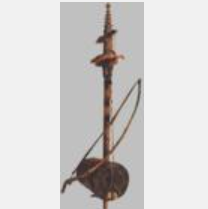Be Wang overview
 Biwang (pinyin: bì wāng) is a Tibetan bow and stringed musical instrument. Tibetan is also called Biyong, Biyang, Bawang, Ri'aza, Zeze, Zani, etc. due to different dialects. Popular in Tibet, Sichuan, Yunnan, Qinghai, Gansu and other provinces. Especially in the areas of Batang, Mangkang and Deqin at the junction of Sichuan, Tibet and Yunnan provinces.
Biwang (pinyin: bì wāng) is a Tibetan bow and stringed musical instrument. Tibetan is also called Biyong, Biyang, Bawang, Ri'aza, Zeze, Zani, etc. due to different dialects. Popular in Tibet, Sichuan, Yunnan, Qinghai, Gansu and other provinces. Especially in the areas of Batang, Mangkang and Deqin at the junction of Sichuan, Tibet and Yunnan provinces.The structure is the same as that of the Han Erhu, which is composed of the qin barrel, the qin rod, the peg, the qin, the qin horse, the qin string and the qin bow. The horn tube is the earliest form of biwang. It is mostly made of thicker bison horn, and the horn of the female bison is the best. Afterwards, because the bison horns were difficult to find, it was gradually changed to a wooden piano tube.
Biwang has a bright pronunciation and a beautiful timbre. Because the bow is short, one more beat is played with one more bow, so the bow is changed more frequently, and the long notes in the melody are played continuously with partials. It can be played solo or as accompaniment for singing and dancing, drama and rap, mainly used for folk singing and dancing strings and Reba strings. Tibetan people usually play chord music solo at home to entertain themselves, which can be played by both men and women.
- Chinese name:Be Wang
- popular area:Tibet, Sichuan, Yunnan, Qinghai, Gansu
- Features:Bright pronunciation and beautiful tone
- Pinyin:bì wāng
overview of other similar instruments
- sanyanxiao overview
- Daguangxian overview
- Leiqin overview
- hahao overview
- yandundagu overview
- Han Xiaozheng overview
- Fang Xiang overview
- guanzi overview
- zhuqin (Dao Qin) overview
- zhuiqin overview
- bangzi overview
- three-stringed piano overview
- Gehu overview
- xiao overview
- xiaokonghou overview
- Konghou overview
- Sheng overview
- suona overview
- hulusi overview
- gushao overview
 渝公网安备 50010702504639号
渝公网安备 50010702504639号